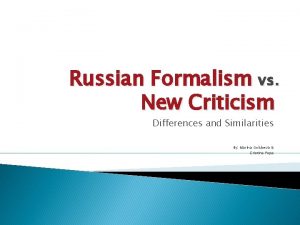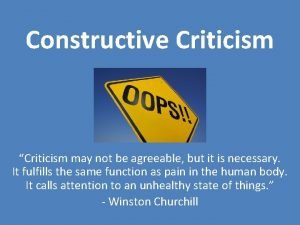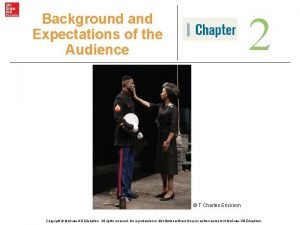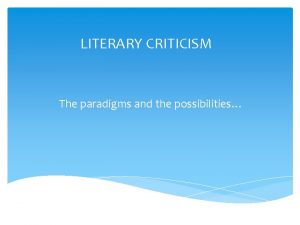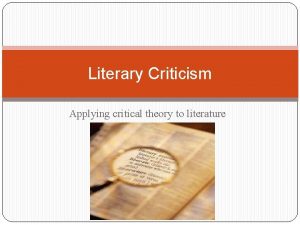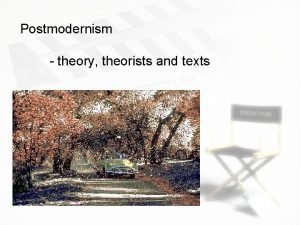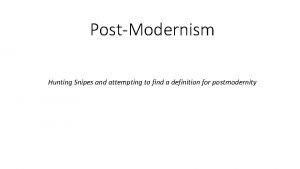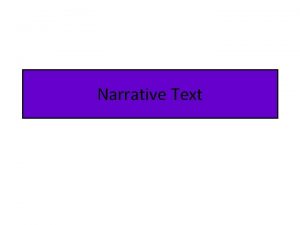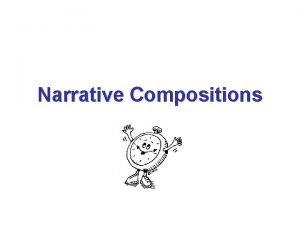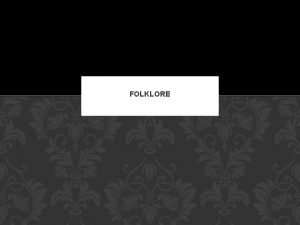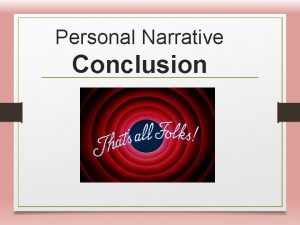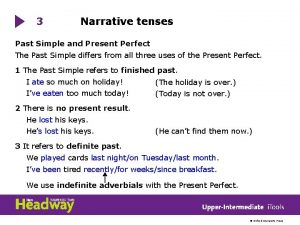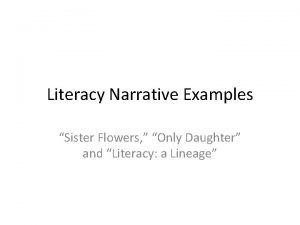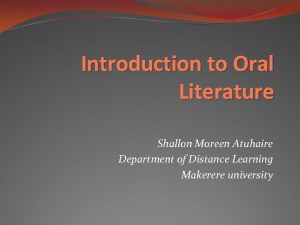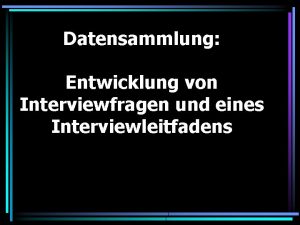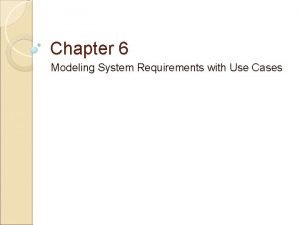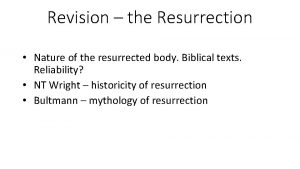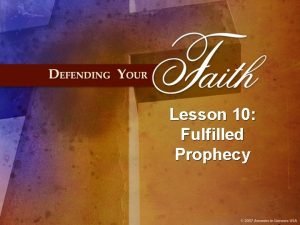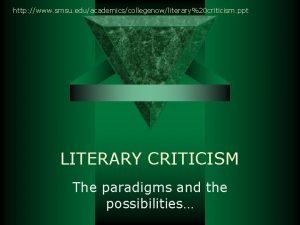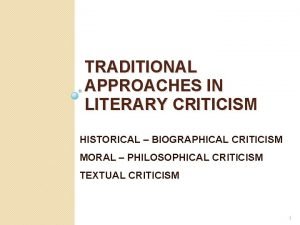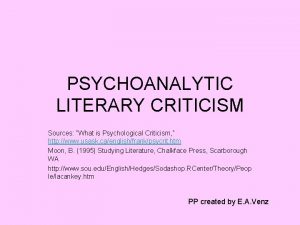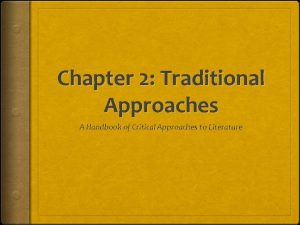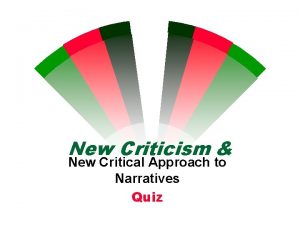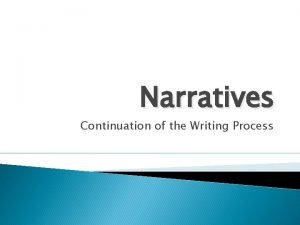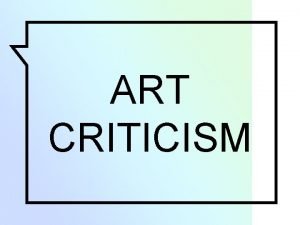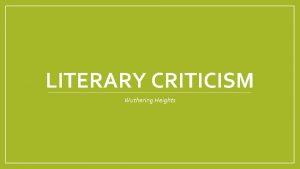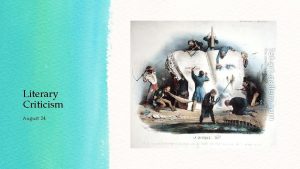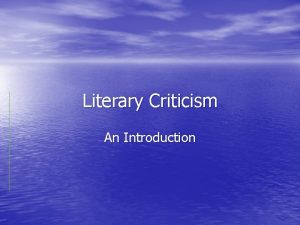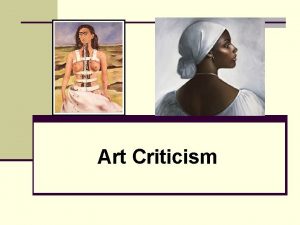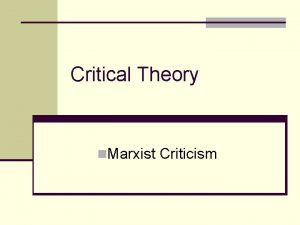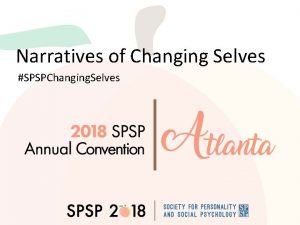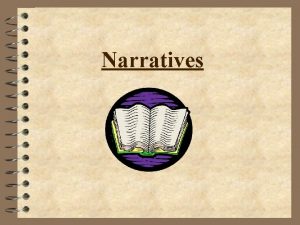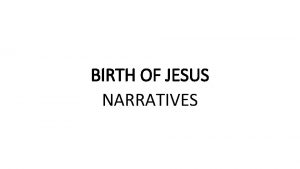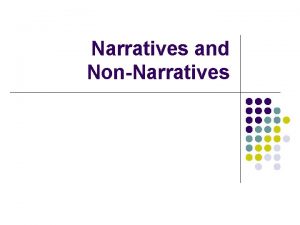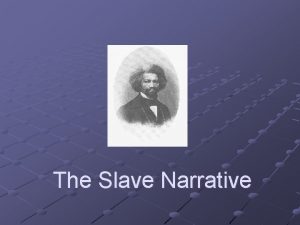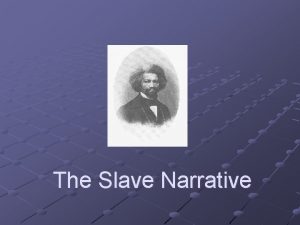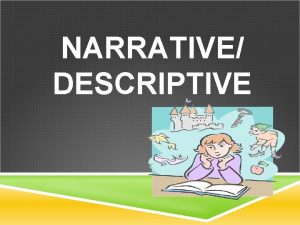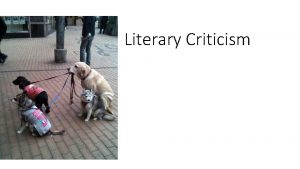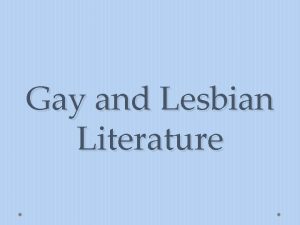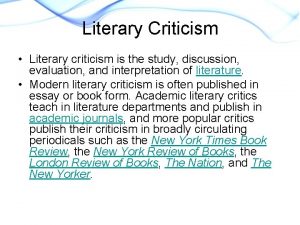New Criticism New Critical Approach to Narratives New





























- Slides: 29

New Criticism & New Critical Approach to Narratives

New Criticism: Major Theorists w T. S. Eliot • objective correlative: The poem is an impersonal formulation of common feelings and emotions. (textbook p. 40) • emphasis on structural analysis • the poet as a catalyst (42) w I. A. Richards, etc.

New Criticism: Major Views A poem is autonomous, with an ontological status. Intentional Fallacy, Affective Fallacy w Poetry offers a different kind of truth (poetic truth) than science. Heresy of Paraphrase w

New Criticism: Methodology (1) Poetry Whole w Parts Denotations, connotations and etymological roots w Allusions Themes w Prosody pattern, tension, w Relationships ambiguities, among paradox, the various elements w contradictions

New Criticism: Methodology (1) Narrative Whole w Parts Point of view, w dialogue, w setting, w Plot w Characterization w Relationships among the various elements w Themes harmonized pattern, tension, ambiguities, paradox, contradictions

母親: Introduction & the major structure Structure: Structure 1. no ending 2. Divided into two part Question: Question How are the two parts different? How are the two parts related to each other? Answers: Answers 1. The contrast between Ms. 吳 and the mother 2. Opposition, parallel, and symmetry between the setting, 3. the point of view, 4. 貓耳 of the two parts

Ms. 吳 the mother Ms. 吳’s appearance: sensual, a lot of colors, sexual 2. implication from 貓耳 ’s point of view 1. She is the object of 貓耳’s desire. 2. Images for her: 像刺 蝟似的刷子—與其他 意象 3. She is beautiful and desirable but dangerous. 1. the mother: w an interior monologue

• the settings and plot of the two parts The first part: 1. The mother’s whole-day lying on the bed // the inactive environment 2. 貓耳 is a child. • Settings: 1. The sun shining, quiet, 整個世界不動; 尤加利 樹 2. 碾石機的聲音 3. 王文興 uses the environment to match/reflect the moods of the mother: esp. the cloud w The second part: 1. When 貓耳 is waiting for Ms. 吳; feels like a hero A lot of motion is described 2. w w Settings: 大榕樹; 吳小姐家

The mother’s interior monologue emotional 2. The mother’s mind is not quite stable. 3. Four men: 貓耳, 谷方, 外國老醫生, 年 輕醫生The husband/doctor-wife relationship 1. • Cf. “Yellow Wallpaper” by Charlotte Perkin Gilman 4. Question: Question Why is she so worried about her son?

The story’s main idea and imagery 1. 2. The story is about a mother’s worries about and fears over her son, while the son needs to be independent. The sentiments of both are conveyed through the description of the settings and the images associated with them, as well as the images associated with the people around them. e. g. The images associated with the mother are inactive ones and related to her sickness. The images associated with Ms. 吳 mean life and sexuality.

How does the mother present 貓 耳? 1. 2. 3. 4. 5. 貓耳 is presented as a young boy, in need of being protected. 貓耳 as a young man, wanting to be independent. The mother confuses the past with the present, and she also confuses the people. She presents herself as “she, ” the third person. She expects the son could cure her as the old doctor cures her. ---a complete dependence of the mother’s part.

Why is the mother so worried about her son? • 沒有關係�我們已經有了貓耳了. • There could be a miscarriage. She expected the second baby but lost it. That’s why she holds on to 貓耳 so much. • 醫生我是你的乖孩子嗎? ……貓耳生 下來是個老醫生? • Confusing the son with the doctor, expecting 貓 耳 to cure her, or to be the only cure for her illness. • Dependant on the son. Submissive to the doctors and the husband.



“A Rose for Emily” Major Argument: w Southern aristocracy, which Emily is first trapped in, holds on to and then gets to represent, is viewed by the town people as a past both dignified and degraded. w

Emily in “A Rose for Emily” Southern aristocracy: the Griersons w Emily is first trapped in and then holds on to the past. e. g. p. 26. w She once tries to break out of it, but she ends up representing it. (her house, p. 25; her images) w Emily // house, broken into by the town people w

“A Rose for Emily” w w w w The narrators’ views of Emily (1) After her father is dead, “glad” (2) When she goes out with Homer Barren, “she will marry him. ” (3) After Barren disappears “She will kill herself. ” (4) the smell “feel sorry for her. ” (5) the tax “dear, inescapable, impervious, tranquil and perverse. ” (6) After Emily is dead. ?

The narrators in “A Rose” The narrators’ views (1): death Tax (2) smell of old Lady Wyatt’s craziness, father’s death w The narrators’ views of Emily and her father w (3) dignity + earthiness; arsenic The narrators’ views of Emily and Homer Barron w (4) The townpeople’s intrusion China painting lesson w (5) House broken into. The only internal view of her. w

New Criticism & New Critical Approach to Narratives Quiz

1. Which of the following are New Criticism’s Major Views w 1. Intentional Fallacy, w 2. Political Correctness w 3. Paraphrase Heresy w 4. Poetic Truth as different from Scientific Truth

2. Which of the following are New Criticism’s Major Views w 1. Intentional Fallacy, w 2. Political Correctness w 3. Paraphrase Heresy w 4. Poetic Truth as different from Scientific Truth





How do we do a New Criticism of “A Rose for Emily”? w 1. Study Faulkner’s presentations of women, w 2. Study the point of view w 3. Analyze the plot development w 4. Find out the contraditions

How do we do a New Criticism of “A Rose for Emily”? w 1. Study Faulkner’s presentations of women, w 2. Study the point of view w 3. Analyze the plot development w 4. Find out the contraditions

Of the images of women we have read, which is the completely positive one? w 1.“Metaphor” I Compare Thee to a Summer’s Day? ” w 3.母親 w 4.Emily in “A Rose for Emily w 5. None of the Above w 2.“Shall

Of the images of women we have read, which is the completely positive one? w 1.“Metaphor” I Compare Thee to a Summer’s Day? ” w 3.母親 w 4.Emily in “A Rose for Emily w 5. None of the Above w 2.“Shall
 Critical semi critical and non critical instruments
Critical semi critical and non critical instruments Semicritical
Semicritical Russian formalism slideshare
Russian formalism slideshare Historical criticism definition
Historical criticism definition Constructive vs destructive criticism
Constructive vs destructive criticism Descriptive criticism vs prescriptive criticism
Descriptive criticism vs prescriptive criticism Literary criticism
Literary criticism Criticism of critical theory
Criticism of critical theory Postmodernism definition
Postmodernism definition Postmodernism grand narratives
Postmodernism grand narratives What is the purpose of narrative text *
What is the purpose of narrative text * What are narratives
What are narratives Oral narratives
Oral narratives Personal narrative conclusion
Personal narrative conclusion Narrative tense
Narrative tense Primeval narratives
Primeval narratives What is a literacy narrative example
What is a literacy narrative example Classification of oral narratives
Classification of oral narratives Interviewleitfaden narratives interview
Interviewleitfaden narratives interview Use case model
Use case model Kyrene educational resources
Kyrene educational resources What is the nature of the resurrection narratives
What is the nature of the resurrection narratives Messianic prophecies fulfilled in the infancy narratives
Messianic prophecies fulfilled in the infancy narratives The narratives that vanquished peoples
The narratives that vanquished peoples Sociological criticism in literature
Sociological criticism in literature Moral approach in literary criticism ppt
Moral approach in literary criticism ppt Historical-biographical criticism
Historical-biographical criticism Psychological criticism literary theory
Psychological criticism literary theory Traditional approach in literature
Traditional approach in literature Approaches in literary criticism
Approaches in literary criticism


